MAD STALKER - FULL METAL FORCE
|
|

|

|
|
マッドストーカー フルメタルフォース
©1994 NEC Home Electronics. Ltd.
©1994 Kogado Studio
©1994 Fill in Cafe Co., Ltd.
Release : 1994-09-15 (¥5800)
ArcadeCDRom² HECD4009
Action / Beat'em up
|
Mad Stalker Full Metal Force is an action/figthing game by Fill in Cafe
and Kogado Studio. In the year 2142 AD, a war ship built during the late
war is discovered in Aremis City. Hundreds of Slavegears mechas are
discovered on-board and are put under military control, and two Slavegears, codenamed
Hound Dog and Rising Dog, are put under the control of the police
for experimental use. However, when the Omega computer suddenly activates itself
on-board the war ship, it freezes Artemis City and orders Rising Dog
to "Exterminate the enemy!". Hound Dog and his pilot, not affected by Omega,
are sent by the police on a perilous mission to counter the attack.
The player can choose between three different mechas at the beginning of the game -
Hound Dog is strong but slow and can use a blaster gun, Kamui is
agile but can only use a blade-weapon and Gong is all round average.
Each mecha can use a variety of moves, from punches, kicks, throw-kicks to
more advanced throws or parry attack moves. The game consists of six stages and also includes
a versus mode.
|
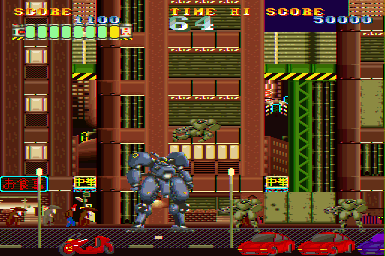 Mad Stalker was first released for the Sharp X68000 in
1994 and was called Mad Stalker Full Metal Forth (picture on the right). The original name was
most probably an unfortunate mistranslation (notice the 'Forth' instead of 'Force) and when the game was
ported to the FM Towns/Marty the same year, it was renamed
Mad Stalker Full Metal Force. Interestingly, the PC Engine
version tested here shows various differences with the original game - the
parallax scrolling is sadly gone, but the game features exclusive cut-scenes
and intro animations not
included in any other releases (see the 'Omake' section on this page). But, most importantly, the PC Engine
port gives the player a choice of three robots to play with at the beginning
of the game, which is was the case in the original version where only
Hound Dog was directly playable (although Kamui and Gong are apparently
'refurbished' enemies from the original game). Finally, Mad Stalker was
curiously released for the Sony Playstation in 1997 - although
this version features improved graphics, it doesn't allow players to choose
a different character for the start. It is also arguable that the new,
improved graphics, don't look as good as the original detailed bitmaps and
the gameplay feels a lot slower overall.
Mad Stalker was first released for the Sharp X68000 in
1994 and was called Mad Stalker Full Metal Forth (picture on the right). The original name was
most probably an unfortunate mistranslation (notice the 'Forth' instead of 'Force) and when the game was
ported to the FM Towns/Marty the same year, it was renamed
Mad Stalker Full Metal Force. Interestingly, the PC Engine
version tested here shows various differences with the original game - the
parallax scrolling is sadly gone, but the game features exclusive cut-scenes
and intro animations not
included in any other releases (see the 'Omake' section on this page). But, most importantly, the PC Engine
port gives the player a choice of three robots to play with at the beginning
of the game, which is was the case in the original version where only
Hound Dog was directly playable (although Kamui and Gong are apparently
'refurbished' enemies from the original game). Finally, Mad Stalker was
curiously released for the Sony Playstation in 1997 - although
this version features improved graphics, it doesn't allow players to choose
a different character for the start. It is also arguable that the new,
improved graphics, don't look as good as the original detailed bitmaps and
the gameplay feels a lot slower overall.
|
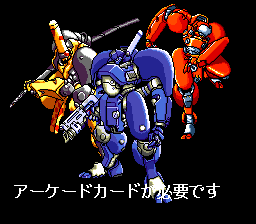 Here is the System Card warning screen for Mad Stalker.
Most Super CDRom² games featured System Card warning screens. These screens appeared
if the player happened to boot up a Super CDRom game with the wrong system card
(under version 3.0 for a Super CDRom², or any system card for an Arcade CDRom²).
Although some of the early games simply didn't boot at all with the wrong card, some started
to display simple warning screens, elaborate animated scenes, and some, such as the popular
Akumajō Dracula X,
even included a short mini-game! Interestingly, these
Super CDRom² warning screens became forgotten pieces of history because most
players used a Duo system (which has a built-in 3.0 system card) to
play their PC Engine CDRom games (Simply use a System Card v1.0,
v2.0 or v2.1 to activate the warning screens on a Duo,
Duo R or Duo RX system).
Here is the System Card warning screen for Mad Stalker.
Most Super CDRom² games featured System Card warning screens. These screens appeared
if the player happened to boot up a Super CDRom game with the wrong system card
(under version 3.0 for a Super CDRom², or any system card for an Arcade CDRom²).
Although some of the early games simply didn't boot at all with the wrong card, some started
to display simple warning screens, elaborate animated scenes, and some, such as the popular
Akumajō Dracula X,
even included a short mini-game! Interestingly, these
Super CDRom² warning screens became forgotten pieces of history because most
players used a Duo system (which has a built-in 3.0 system card) to
play their PC Engine CDRom games (Simply use a System Card v1.0,
v2.0 or v2.1 to activate the warning screens on a Duo,
Duo R or Duo RX system).
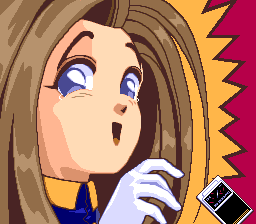 However, there is something particularly interesting about Mad Stalker - there is
a hidden screen in the game (see the 'Secrets' section below to activate it) that
shows a girl holding what looks like a Super System Card v.3.0. She eventually
shed tears and drops the card. Although Mad Stalker was released as
an Arcade Card game, it is argued that it doesn't feature the technical feast
usually associated with Arcade Card games and it could have certainly worked with
a Super System Card. Could this hidden screen be the discarded warning message supposed to
be displayed if the game was booted without a Super System Card? Which may
indicate that the game was originally designed to be a Super System Card game,
and not an Arcade Card game - and maybe this was changed later in production, either
for technical or marketing reasons. This would also explain why the actual Arcade Card warning
for Mad Stalker looks so simple, maybe it was a last-minute decision.
However, there is something particularly interesting about Mad Stalker - there is
a hidden screen in the game (see the 'Secrets' section below to activate it) that
shows a girl holding what looks like a Super System Card v.3.0. She eventually
shed tears and drops the card. Although Mad Stalker was released as
an Arcade Card game, it is argued that it doesn't feature the technical feast
usually associated with Arcade Card games and it could have certainly worked with
a Super System Card. Could this hidden screen be the discarded warning message supposed to
be displayed if the game was booted without a Super System Card? Which may
indicate that the game was originally designed to be a Super System Card game,
and not an Arcade Card game - and maybe this was changed later in production, either
for technical or marketing reasons. This would also explain why the actual Arcade Card warning
for Mad Stalker looks so simple, maybe it was a last-minute decision.
|
Game Staff (Copied from the end credits) :
|
Cast:
Chico Rodrigues:
Hans Dolman:
Ryuzaburoh Ohtomo
Richard Winston:
Mitsuru Miyamoto
Eve Lurdia:
Bianca Howman:
Ayako Shiraishi
Jemmy Chen:
Michiko Gleasia:
Ikue Ohtani
Michaeve Goldvitz:
Yutaka Nakano
Mad Stalker Staff:
Executive Producer:
Kiyoaki Yasuda (NEC)
Akira Kila
Superviser:
Masao Takeuchi (NEC)
Nobuhiro Aga
Producer:
Hirotada Hashimoto (NEC)
Director:
Ippey Tani
|
|
Game Planning:
Masaya Konya
Game Design:
Masatoshi Imaizumi
Character Design:
Hideki Inoue
"Slavegear" Design:
Tatsumi Minegishi
Music Compose:
Keishi Yonao
MStory Composition:
Masayuki Kashi
Main Program:
Toshio Obata
Visual Program:
Takumi Amano
Graphic Design:
Kenishi Maejima
Yoshitomo Hara
Naohiro Washio
Masatoshi Imaizumi
Kaita Hamamoto
Masatada Itoh
Yoshio Shirai
Taku Takayama
Junichi Fukuda
|
|
Promotion:
Hideo Kuwabara (NEC)
Nobuyuki Kondo (NEC)
Marketing:
NEC Personal Systems. Ltd.
Special Thanks:
Nobuhiro Takagaki (NEC)
Goro Fukagawa (NEC)
Naoko Asano (NEC)
Humihiko Matubara (NEC)
Hideyuki Kiseki
Naomi Yamasaki
Eri Murata
Masako Tsunoda
Yozo Watanabe
Junitiro Saito
Toshinobo Kondo
Akio Murata
Keiko Matsumura
Toru Hosaka
Rise Spirit Inc.
Central Recording Co.,Ltd
Family Soft Co.,Ltd
Copyright:
Nec Home Electronics, Ltd.
Kogado Studio
Fill in Cafe Co.,Ltd.
|
|
O
M
A
K
E
|
|
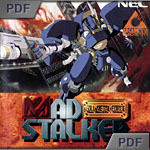
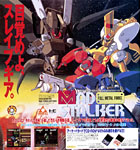
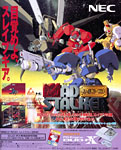
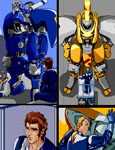
|
|
|
Click on picture to enlarge |
S
E
C
R
E
T
S
|
|
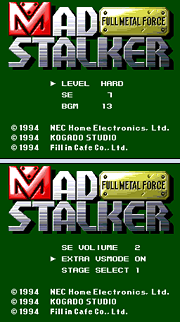 Hidden Option Screen:
Hidden Option Screen:
At the title screen, go the Option Menu and select the hard
level, set the SE to 7 and the BGM to 13. Now go
back to the level option and press I. You should now have access
to the hidden option screen (picture on the right).
There you can select the Sound Effects volume. But most
interestingly you can activate the Extra VS mode that allows
you to unlock a new set of characters giving you the
opportunity to play the game with many more characters that the
original three Slavegears.
Finally, and not the least, you also have access to a Stage Select and
start the game from any stage.
Unlock more characters for the VS mode:
At the title screen, activate the VS mode. When done, hold Select
and press Run. You now have access to more characters, which even includes
Eater, Solder, Dath Ball and Stunbeat!
Alternate Intro Screens:
This one is really odd - when the Kodago logo appears, as the game boots up,
hold I, II and Select (make sure the auto-fire is off!).
An additional screen with a girl and a cat will then appear with the
words Presented by Nekosan Chīmu, which can be translated as Presented by
the Cat team.
But that's not all! If you hold the buttons while this screen is displayed, another
one will appear with a girl holding what looks like a Super System Card Ver.3.0!
(See the 'System Card' warning message section on this page for more information).
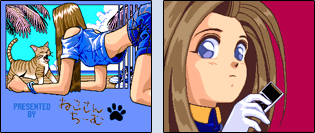
|
|
|
|
LK

|
|
Add your Pov here !
|
P
O
V
s
|
|
I have profoundly mixed feelings about Mad Stalker.
The game is not all bad - sprites are fairly large on screen and
the graphics are overall correct, although not outstanding. No, the main problem
are the controls - they are very awkward to master, well,
I'm still impressed by how
they managed to pack so many moves only using two action buttons, but
doing a quart-circle to use the blaster gun is very frustrating.
The first boss, for instance, is a nightmare to beat, only because you
feel seriously let down by the awkward control system.
It is a shame because the mecha designs are excellent and the levels are somewhat fun
.. although very repetitive, Mad Stalker
definitively needs more enemy/boss variation especially when you reach the game's half way point.
Granted, Mad Stalker is way better that the average Genocide or
the equally bad Browning, but it feels like another missed
opportunity. But as a Mecha-beat'em up game, it is one of the
best available for the PC Engine system in my opinion.
|
|
|
|